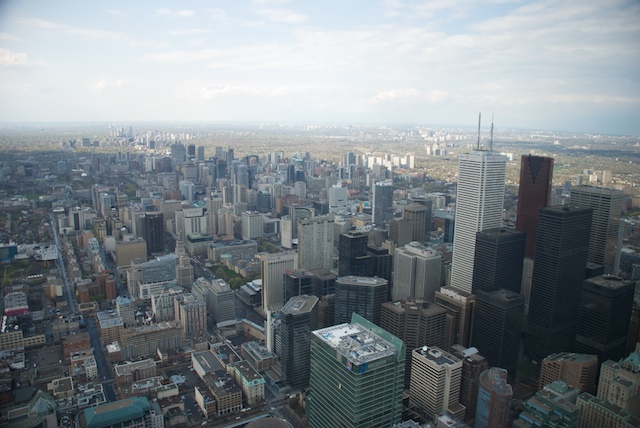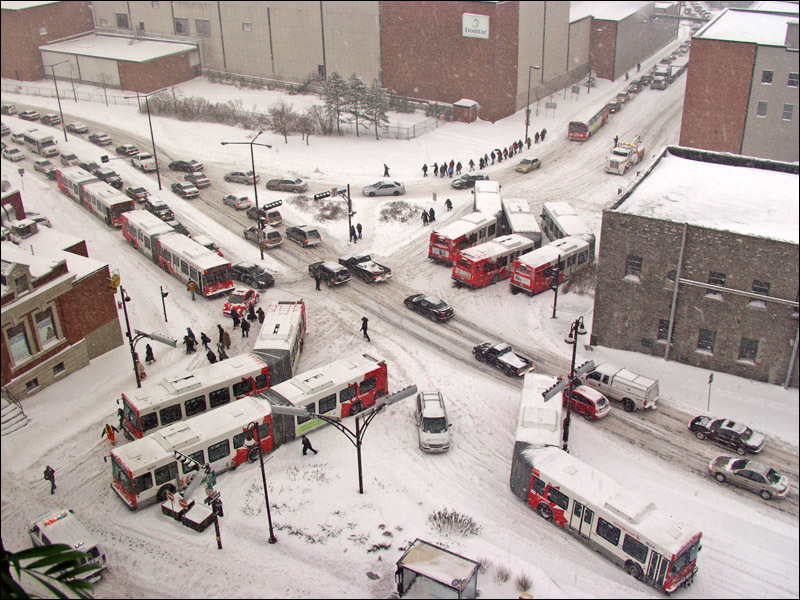In the burbs you can't do it. Because one-ways have to run in pairs, and the grid in most of the burbs in 2km between arterials. That means if you ran 1-way pairs, you might have to go 4km out of your way to turn back get to where you were going.
Most streets in the inner suburb are 100 m apart in a grid pattern, so there's no reason why converting them to one-way streets will lead to significant increase in driving distance (not that there's a
need for them to be one-way, yet).
In Toronto's favour:
I can't think of any transit that better integrates its surface and underground/rail routes as seamlessly. In many older cities there was simply no where to build bus terminals at stations etc.; and in many cities Bus and Subway are 2 separate systems and fares. So I think the TTC deserves full points for that.
HK integrates all its modes of transportation (metro, railway, light rail, bus, jitneys, ferries) just as well, if not much better, than Toronto. Most metro/railway stations, even the ones in the inner core, have large bus or light rail terminals directly above/next to them (usually underneath highrise developments). The fare system of all transit modes, even though they are operated by different companies, is fully integrated. Most other cities in the world, even though different modes are operated by different companies, still have fully integrated fare systems.
The lack of a Zone system isn't unique, though, for a City our size it is unusual in my experience.
New York, Chicago, Montreal and Boston also don't have fare zones, just to name a few North American examples of "cities our size" (population or area). Paris also doesn't have fare zones for its metro, only for RER (but GO transit, just like the commuter rails in the cities listed above, also have fare zones). Most Asian cities (HK, Tokyo, Taipei, Singapore) don't use fare zones but calculate fare based on distance travelled.
It would be near impossible these days to expropriate enough properties to build subway diagonally, at least in residential areas.
Tunnelling by deep bore, albeit more expensive, does not require significant expropriation of properties.
Regarding one way streets: there is certainly a factor in how a one-way street is designed. From what I've seen of Buenos Aires, the avenues are wide, and the sidewalks are wide. There are buffer zones between the fast moving vehicles and the pedestrians, which allows a good pedestrian zone to thrive.
In the Canadian (or North American) experience, most one-way streets are taken from streets which are two-way. They are converted with the purpose of moving car traffic faster, and the pedestrian is automatically considered to be second best in this arrangement. The cars go faster; they're louder, more intrusive, and in order to get as many lanes as possible (three lanes in the case of Duke/Charles; three to four lanes in the case of Richmond/Adelaide), the roadway goes right up to a narrowed sidewalk, often with no parking or anything to provide a buffer zone between car and pedestrian.
...
It's probably quite possible to build one-way streets that offer good pedestrian space, but it's more likely to happen when the street is designed from the start with both cars and pedestrians in mind. By converting two-way streets into one-way streets, you're making a judgment that values cars ahead of pedestrians. And pedestrian space tends to suffer as a result.
Given that almost all streets in the downtowns of Manhattan, Boston, Chicago, SF, etc are one-way, and most of them have reasonably vibrant streetlife and/or have a pedestrian-friendly setting, it is hardly a general North Amercan experience that converting a street to one-way automatically kills streetlife. You are absolutely correct though, as many people here have pointed out, that it is the design, streetscape and retail that determines whether a street is vibrant or not. For every one-way street that one-way haters point out is dead, there is at least one two-way street that is just as dead.
I'd absolutely call it an idiosyncrasy - certainly we're unique amongst North American transit services in that our farebox pays for a huge portion of our transit budget.
We don't have an expectation that other public-services (hospitals, fire departments, police forces, the military, road construction, park services...) be self-sufficient.
It's easy to have a farebox ratio of near 100% - you just raise fares whenever you need to make up a budget shortfall. But such a strategy is terrible for route and ridership expansion and basically causes everything to stagnate.
I know you are only talking about North America (not much of an idiosyncracy given the small sample size), but it is common for most Asian systems to have fare revenue account for 60% to over 95% of total revenue, and still make hundreds of millions of dollars of profit (even for systems with comparable or smaller ridership, like Singapore or Taipei). This goes to show that having a high farebox ratio does not require raising fees all the time and compromising the network/service (though arguably it is at the expense of giving employees lower salary/less benefits than what many North American systems give). It also shows that public services can, and do, become self-sufficient.






